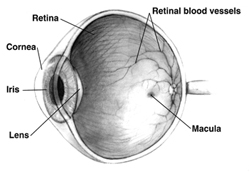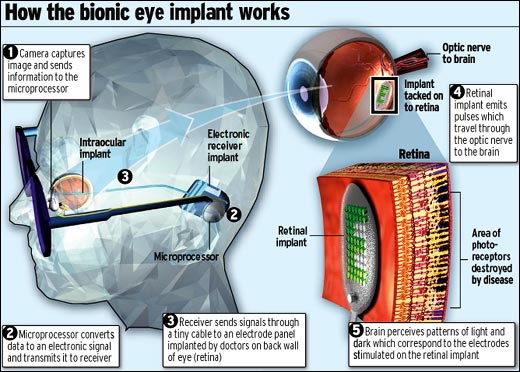 Seeing, it’s one of our five senses, and it is kind of important for getting around. Almost all animals have some kind of ability to see, with hawks and eagles having the best vision and rats having some of the worse. And then there are bats which can hardly see at all.
Seeing, it’s one of our five senses, and it is kind of important for getting around. Almost all animals have some kind of ability to see, with hawks and eagles having the best vision and rats having some of the worse. And then there are bats which can hardly see at all.
 Scientists have been studying the way the retina works. The retina is the part inside of your eye that responds to light and helps to collect images that allow you to see. The retina is made up of cells called cones and rods that are special since they respond to light. The average human eye has about a million cells and within those cells about 150 million photoreceptors. Nerve cells then connect these photoreceptors to your brain. But not every photoreceptor is wired into your brain, so in your eye there is some information processing going on. There is a lot of information that moves from your eyes into your brain and scientists have estimated it to be around 8.75 megabits per second, that’s around 5-10 times faster than a T-1 fiber optic cable.
Scientists have been studying the way the retina works. The retina is the part inside of your eye that responds to light and helps to collect images that allow you to see. The retina is made up of cells called cones and rods that are special since they respond to light. The average human eye has about a million cells and within those cells about 150 million photoreceptors. Nerve cells then connect these photoreceptors to your brain. But not every photoreceptor is wired into your brain, so in your eye there is some information processing going on. There is a lot of information that moves from your eyes into your brain and scientists have estimated it to be around 8.75 megabits per second, that’s around 5-10 times faster than a T-1 fiber optic cable.
If we know more about how the eye works then maybe someday we can build artificial parts that might help people with visual impairments to see better. Can nanotechnology help create artificial eyes? Scientists have made some progress using technology that is similar to the kinds of chips that are found in digital cameras.

The big challenge is not capturing the image since nanotechnology can be used to make very small artificial retinas that are only a few millimeters across. No, the real challenge is taking that information collected on the artificial retina chip and somehow directing that information to the brain. Clinical trials have already been started with the artificial retina mounted on a pair of glasses and then the electrodes then wired into the retina of the patient. What do the patients see? Not real images but bits and pieces that mainly correspond to light and dark. Part of the challenge for the patient is retraining the brain to understand this information. There is still a lot of work to be done, but things are moving along!
